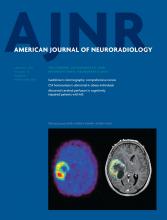Research ArticleBrain
Open Access
Application of 62Cu-Diacetyl-Bis (N4-Methylthiosemicarbazone) PET Imaging to Predict Highly Malignant Tumor Grades and Hypoxia-Inducible Factor-1α Expression in Patients with Glioma
K. Tateishi, U. Tateishi, M. Sato, S. Yamanaka, H. Kanno, H. Murata, T. Inoue and N. Kawahara
American Journal of Neuroradiology January 2013, 34 (1) 92-99; DOI: https://doi.org/10.3174/ajnr.A3159
K. Tateishi
aFrom the Departments of Neurosurgery (K.T., M.S., H.K., H.M., N.K.)
U. Tateishi
bRadiology (U.T., T.I.), Graduate School of Medicine, Yokohama City University, Yokohama, Japan
M. Sato
aFrom the Departments of Neurosurgery (K.T., M.S., H.K., H.M., N.K.)
S. Yamanaka
cDepartment of Pathology (S.Y.), Yokohama City University Hospital, Yokohama, Japan.
H. Kanno
aFrom the Departments of Neurosurgery (K.T., M.S., H.K., H.M., N.K.)
H. Murata
aFrom the Departments of Neurosurgery (K.T., M.S., H.K., H.M., N.K.)
T. Inoue
bRadiology (U.T., T.I.), Graduate School of Medicine, Yokohama City University, Yokohama, Japan
N. Kawahara
aFrom the Departments of Neurosurgery (K.T., M.S., H.K., H.M., N.K.)

References
- 1.↵
- Ohgaki H,
- Kleihues P
- 2.↵
- Louis DN,
- Ohgaki H,
- Wiestler OD,
- et al
- 3.↵
- 4.↵
- 5.↵
- Kayama T,
- Yoshimoto T,
- Fujimoto S,
- et al
- 6.↵
- Rampling R,
- Cruickshank G,
- Lewis AD,
- et al
- 7.↵
- Swanson KR,
- Chakraborty G,
- Wang CH,
- et al
- 8.↵
- Hirata K,
- Terasaka S,
- Shiga T,
- et al
- 9.↵
- 10.↵
- 11.↵
- Lewis JS,
- Sharp TL,
- Laforest R,
- et al
- 12.↵
- Obata A,
- Yoshimi E,
- Waki A,
- et al
- 13.↵
- O'Donoghue JA,
- Zanzonico P,
- Pugachev A,
- et al
- 14.↵
- Dehdashti F,
- Grigsby PW,
- Lewis JS,
- et al
- 15.↵
- 16.↵
- Lewis JS,
- Laforest R,
- Dehdashti F,
- et al
- 17.↵
- Lohith TG,
- Kudo T,
- Demura Y,
- et al
- 18.↵
- 19.↵
- 20.↵
- 21.↵
- Fujibayashi Y,
- Taniuchi H,
- Yonekura Y,
- et al
- 22.↵
- Lewis JS,
- McCarthy DW,
- McCarthy TJ,
- et al
- 23.↵
- Kato T,
- Shinoda J,
- Nakayama N,
- et al
- 24.↵
- Nariai T,
- Tanaka Y,
- Wakimoto H,
- et al
- 25.↵
- 26.↵
- 27.↵
- 28.↵
- Huang LE,
- Arany Z,
- Livingston DM,
- et al
- 29.↵
- Huang LE,
- Gu J,
- Schau M,
- et al
- 30.↵
- Jiang BH,
- Semenza GL,
- Bauer C,
- et al
- 31.↵
- 32.↵
- Skovgaard D,
- Kjaer M,
- Madsen J,
- et al
- 33.↵
- Birner P,
- Preusser M,
- Gelpi E,
- et al
- 34.↵
- Kaur B,
- Khwaja FW,
- Severson EA,
- et al
- 35.↵
- Korkolopoulou P,
- Patsouris E,
- Konstantinidou AE,
- et al
- 36.↵
- 37.↵
- Qiang L,
- Wu T,
- Zhang HW,
- et al
- 38.↵
- 39.↵
- 40.↵
- 41.↵
- Höckel M,
- Vaupel P
- 42.↵
- 43.↵
- Bar EE,
- Lin A,
- Mahairaki V,
- et al
- 44.↵
- Mathieu J,
- Zhang Z,
- Zhou W,
- et al
- 45.↵
- Zhou Y,
- Zhou Y,
- Shingu T,
- et al
- 46.↵
In this issue
Advertisement
K. Tateishi, U. Tateishi, M. Sato, S. Yamanaka, H. Kanno, H. Murata, T. Inoue, N. Kawahara
Application of 62Cu-Diacetyl-Bis (N4-Methylthiosemicarbazone) PET Imaging to Predict Highly Malignant Tumor Grades and Hypoxia-Inducible Factor-1α Expression in Patients with Glioma
American Journal of Neuroradiology Jan 2013, 34 (1) 92-99; DOI: 10.3174/ajnr.A3159
0 Responses
Application of 62Cu-Diacetyl-Bis (N4-Methylthiosemicarbazone) PET Imaging to Predict Highly Malignant Tumor Grades and Hypoxia-Inducible Factor-1α Expression in Patients with Glioma
K. Tateishi, U. Tateishi, M. Sato, S. Yamanaka, H. Kanno, H. Murata, T. Inoue, N. Kawahara
American Journal of Neuroradiology Jan 2013, 34 (1) 92-99; DOI: 10.3174/ajnr.A3159
Jump to section
Related Articles
- No related articles found.
Cited By...
- 62Cu-Diacetyl-Bis (N4-Methylthiosemicarbazone) PET in Human Gliomas: Comparative Study with [18F]Fluorodeoxyglucose and L-Methyl-[11C]Methionine PET
- Interrogating Tumor Metabolism and Tumor Microenvironments Using Molecular Positron Emission Tomography Imaging. Theranostic Approaches to Improve Therapeutics
This article has not yet been cited by articles in journals that are participating in Crossref Cited-by Linking.
More in this TOC Section
Similar Articles
Advertisement











